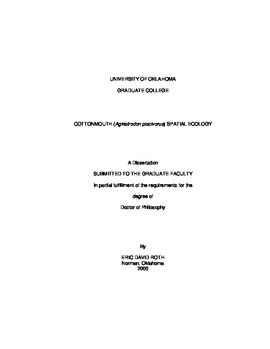| dc.contributor.advisor | Vitt, Laurie J., | en_US |
| dc.contributor.author | Roth, Eric David. | en_US |
| dc.date.accessioned | 2013-08-16T12:19:38Z | |
| dc.date.available | 2013-08-16T12:19:38Z | |
| dc.date.issued | 2005 | en_US |
| dc.identifier.uri | https://hdl.handle.net/11244/836 | |
| dc.description.abstract | Radio-telemetry was used to study spatial ecology of a Cottonmouth (Agkistrodon piscivorus) population in eastern Texas. I examined effects of sex, reproductive state, and body size on spatial use within a riparian habitat. Snakes inhabited a relatively linear environment, restricting movements to the vicinity of the stream. Males occupied larger home ranges than both gravid and non-gravid females. Gravid females exhibited marginally larger home ranges than non-gravid females, but any effects attributable to reproductive state were relatively small when compared to sex differences in spatial use. Body size was positively correlated with home range size but did not account for observed home range differences among population subunits. | en_US |
| dc.format.extent | viii, 113 leaves : | en_US |
| dc.subject | Spatial behavior in animals Texas. | en_US |
| dc.subject | Snakes Texas. | en_US |
| dc.subject | Agkistrodon piscivorus Texas. | en_US |
| dc.subject | Biology, Ecology. | en_US |
| dc.subject | Spatial ecology Texas. | en_US |
| dc.title | Cottonmouth (Agkistrodon piscivorus) spatial ecology. | en_US |
| dc.type | Thesis | en_US |
| dc.thesis.degree | Ph.D. | en_US |
| dc.thesis.degreeDiscipline | Department of Biology | en_US |
| dc.note | Adviser: Laurie J. Vitt. | en_US |
| dc.note | Source: Dissertation Abstracts International, Volume: 66-01, Section: B, page: 0060. | en_US |
| ou.identifier | (UMI)AAI3162830 | en_US |
| ou.group | College of Arts and Sciences::Department of Biology | |
